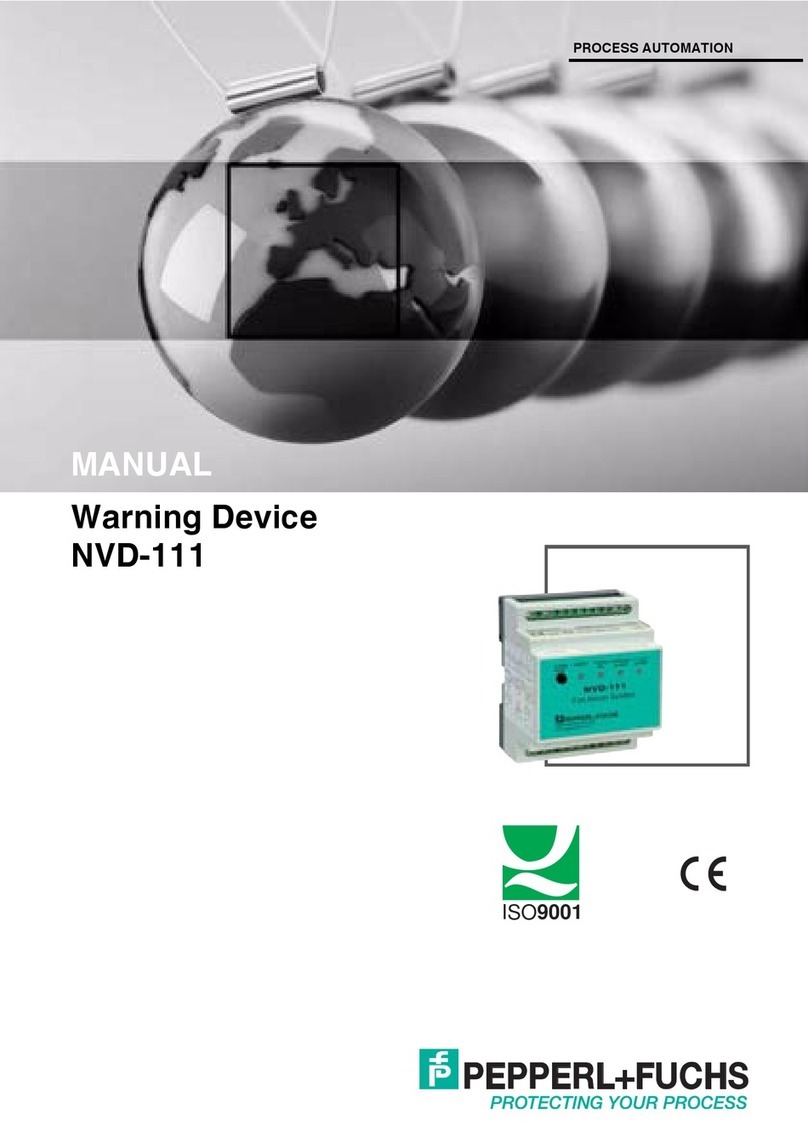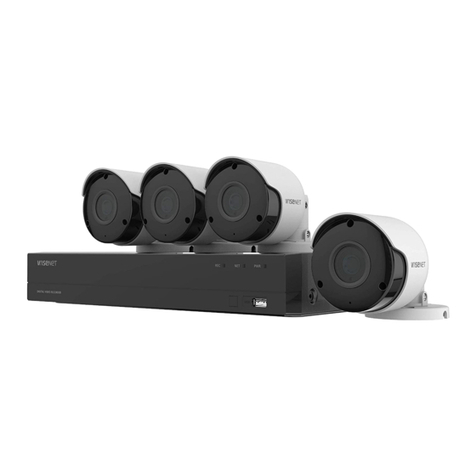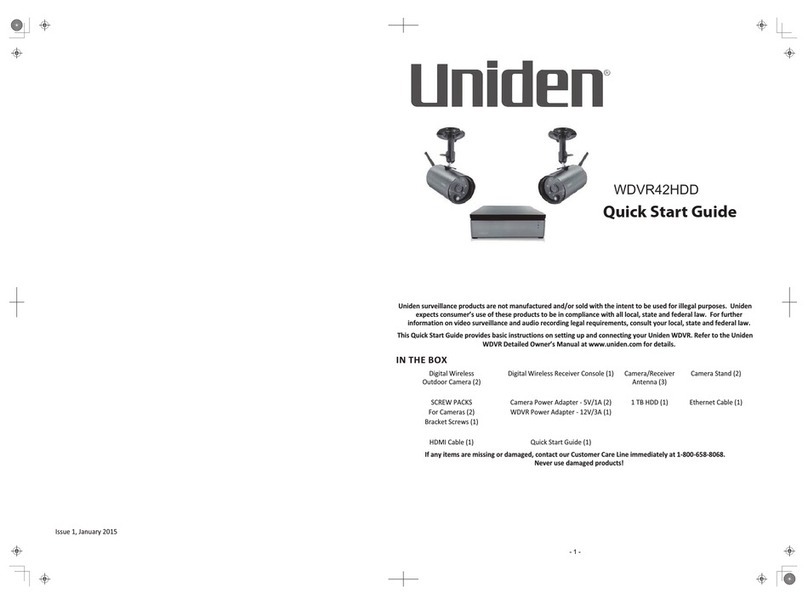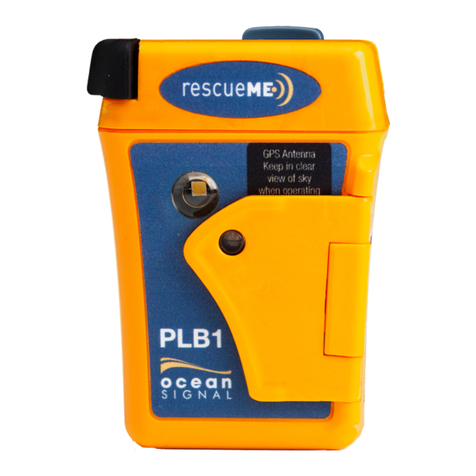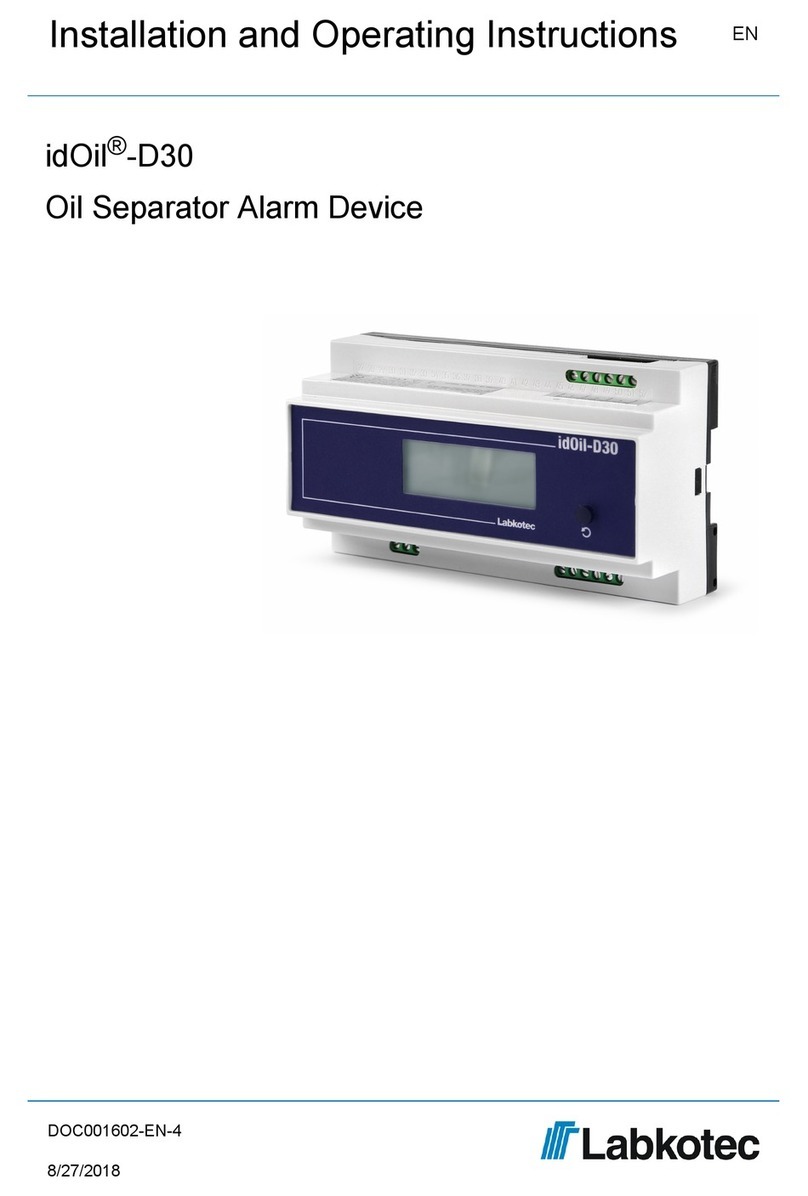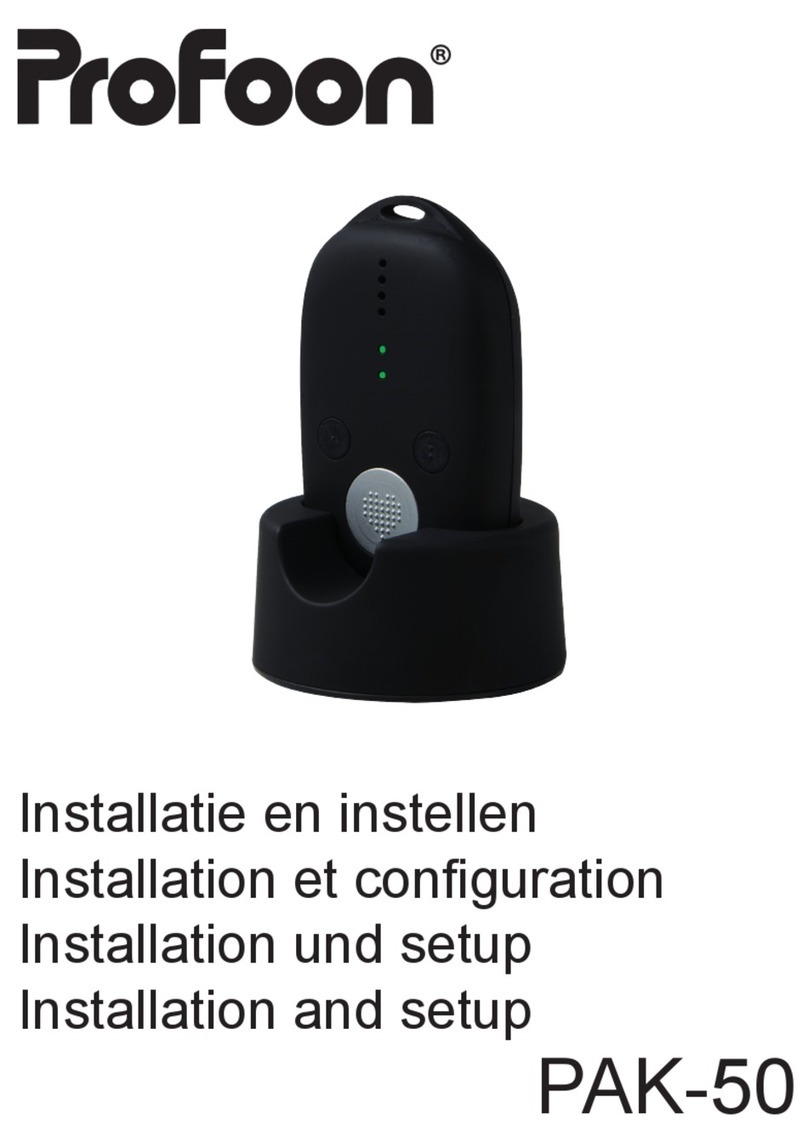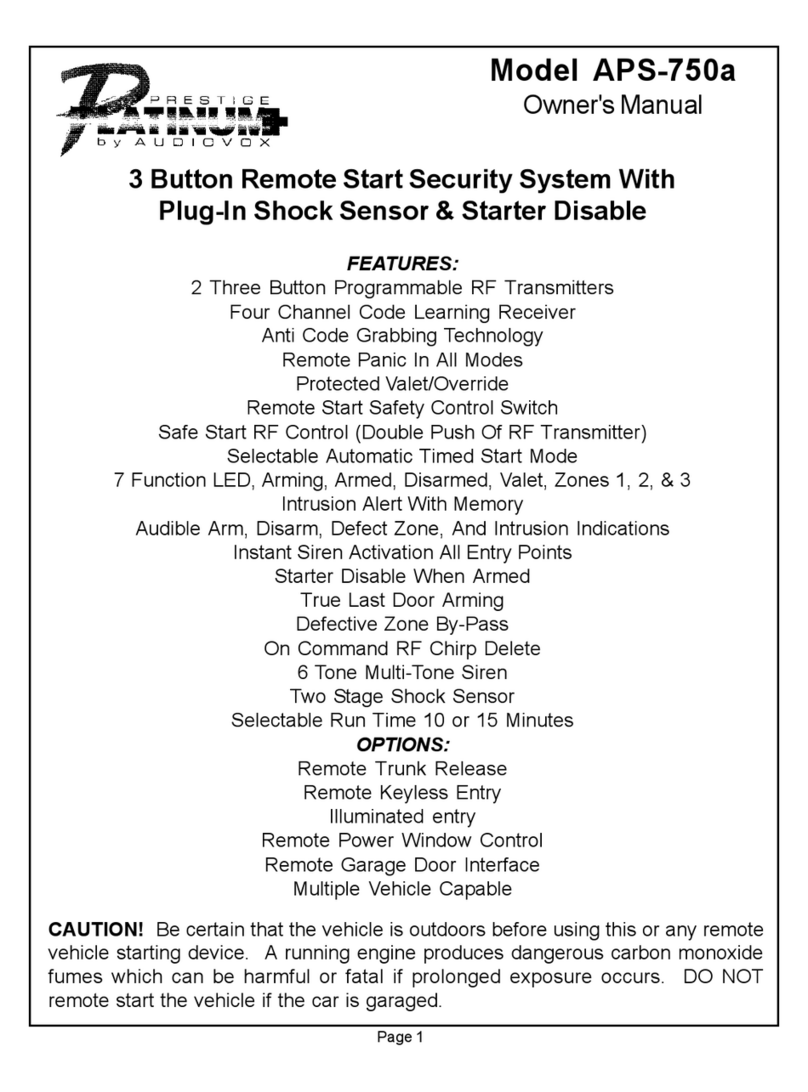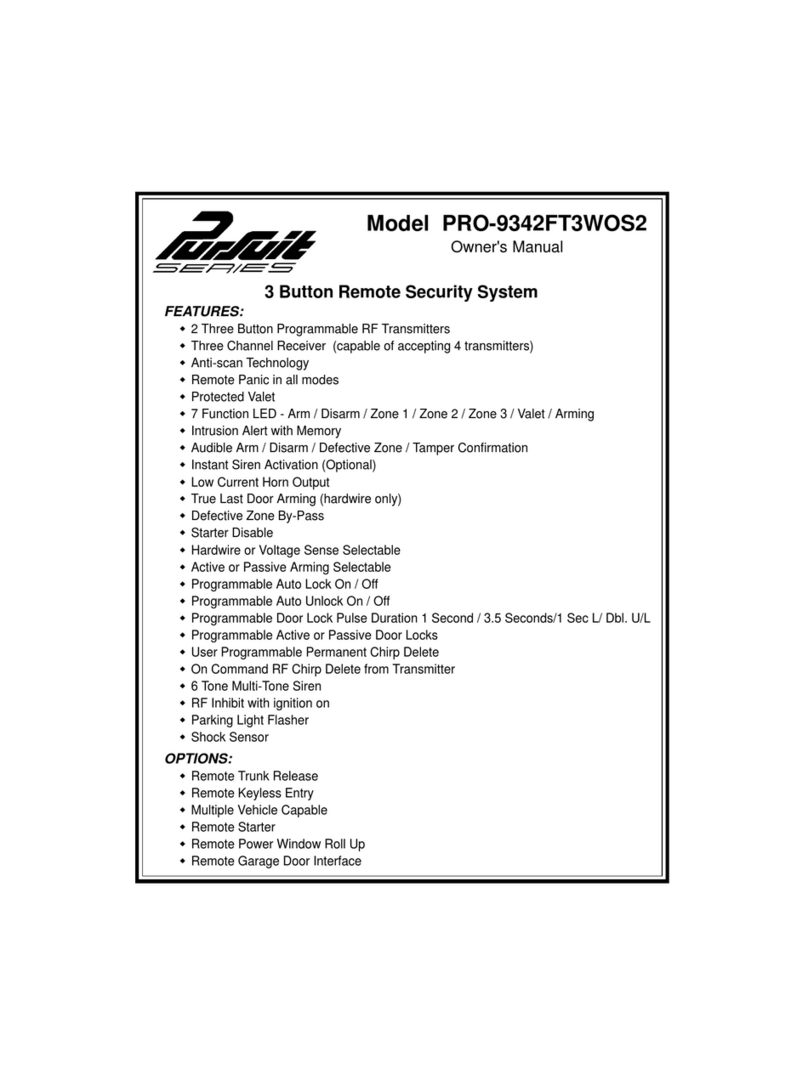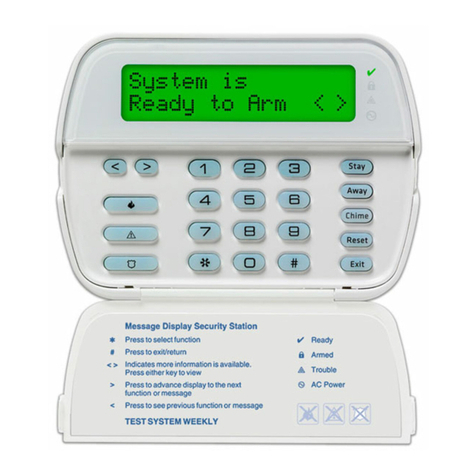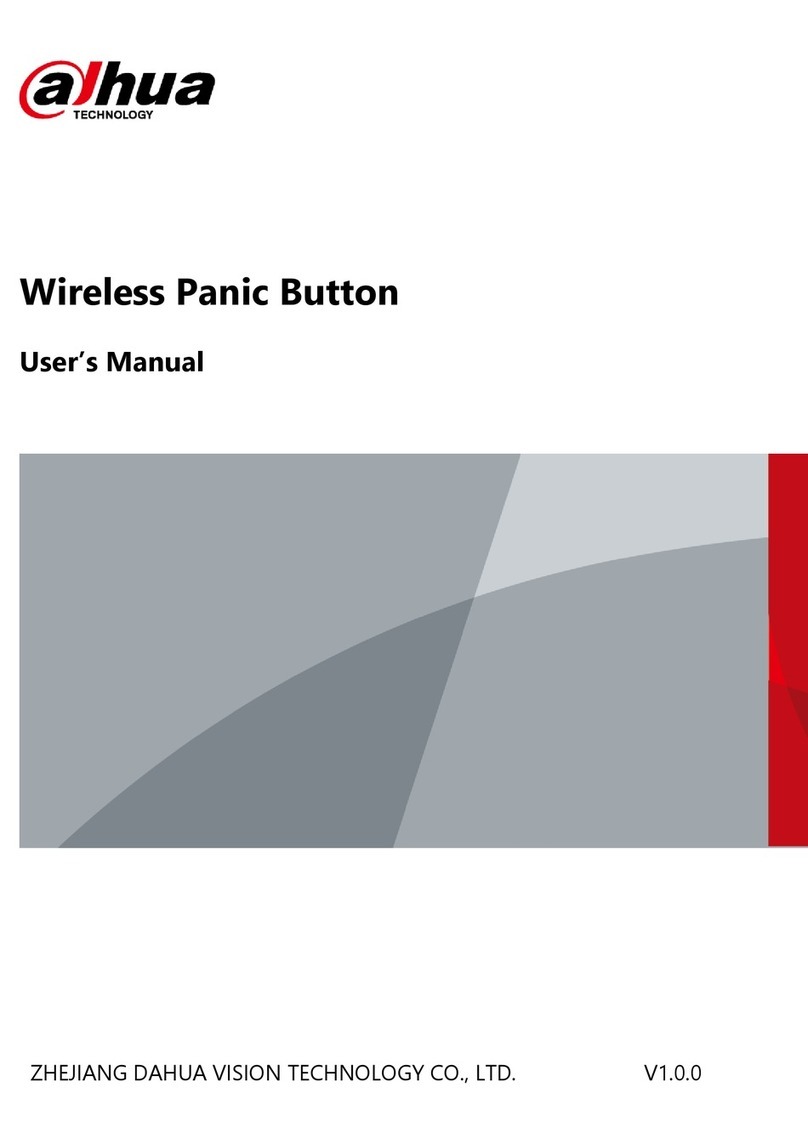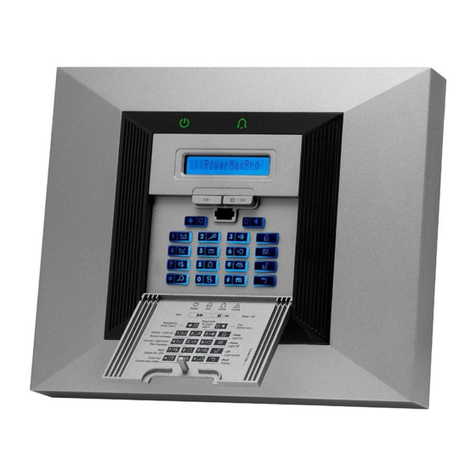Telefire ADR-3000 Reference manual

ADR-3000
ANALOG ADDRESSABLE
INTELLIGENT FIRE ALARM SYSTEM
System Introduction
Manufacturer TELEFIRE Fire & Gas Detectors LTD
5 Halapid St.
P.O.B. 7036
Petach Tikva 49250
Israel
Tel: + 972 3 921 1955
Fax: + 972 3 921 1816
Email: [email protected]
Web Site: www.telefire.co.il
4 November 2004
Revision: 1.10

Telefire ADR-3000 – System Introduction
Revision 1.10 4 November 2004
Table of Contents
LIST OF FIGURES ..............................................................................................III
1 SYSTEM INTRODUCTION ............................................................................1
2 FIRE ALARM CONTROL PANEL..................................................................2
2.1 INTRODUCTION .......................................................................................................2
2.2 COMPONENTS OF THE ADR-3000 CONTROL PANEL ................................................2
2.3 ADR-3001 MAIN BOARD ........................................................................................3
2.3.1 Low-Voltage Connections........................................................................................... 3
2.4 ADR-3002
AND ADR-3002C LINE CARDS ..............................................................4
2.4.1 Maximum Addressing Capacity .................................................................................. 4
2.5 ADR-3003 DISPLAY AND KEYBOARD MODULE ........................................................5
2.6 ADR-4004TSW SWITCHING POWER SUPPLY .........................................................5
2.7 LON-3000 NETWORK COMMUNICATION MODULE ....................................................5
2.7.1 Topology ..................................................................................................................... 5
2.8 NET-3000 INTERNET ENABLED MONITORING AND NOTIFICATION MODULE ...............6
2.9 GIM-232 GALVANIC ISOLATION MODULE FOR RS-232 INTERFACE...........................7
2.10 MCID-34 MODEM MODULE ....................................................................................7
2.11 RM-4005 REMOTE PANEL AND ANNUNCIATOR ........................................................8
3 INITIATING DEVICES....................................................................................9
3.1 INTRODUCTION .......................................................................................................9
3.2 ANALOG ADDRESSABLE DETECTORS AND INITIATING DEVICES .................................9
3.2.1 TFO-440A Analog Addressable Photoelectric Smoke Detector................................. 9
3.2.2 TPH-442A Analog Addressable Multisensor Photoelectric Smoke / Heat Detector.10
3.2.3 TFI-330A Analog Addressable Ionization Smoke Detector...................................... 10
3.2.4 TFH-220A Analog Addressable Heat Detector ........................................................ 10
3.2.5 TFL-1NA Auxiliary Indicator for Analog Detectors.................................................... 11
3.2.6 TFB-110A Common Base for Analog Addressable Detectors .................................11
3.2.7 TPB-800ASR Manual Fire Alarm Call Point ............................................................. 11
3.2.8 TPB-800ASY Manual Extinguishing Call Point ........................................................ 11
4 ACCESSORIES ...........................................................................................12
4.1 INTRODUCTION .....................................................................................................12
4.2 ANALOG ADDRESSABLE MODULES ........................................................................12
4.2.1 Input Modules ........................................................................................................... 12
4.2.2 Output Modules ........................................................................................................ 12
4.2.3 Multifunction Modules............................................................................................... 12
4.2.4 Other Accessories .................................................................................................... 12
4.2.5 ADR-805 Flow Switch Interface Module................................................................... 12
4.2.6 ADR-810 Single-Channel Input Module ................................................................... 13
4.2.7 ADR-812 Two-Channel Input Module ...................................................................... 13
4.2.8 ADR-818 Eight-Channel Input Module ..................................................................... 14
— I —

Telefire ADR-3000 – System Introduction
Revision 1.10 4 November 2004
4.2.9 ADR-820 Single-Channel Output Module ................................................................ 14
4.2.10 ADR-828 Eight-Channel Output Module .................................................................. 15
4.2.11 ADR-823 Three-Channel Input/Output Module ........................................................ 15
4.2.12 ADR-833 Extinguishing Control Unit ........................................................................ 16
4.2.13 LI-3000 Line Isolation Module for Class A/B ............................................................ 16
4.2.14 TIP-224A Analog Addressable Indoor Alarm Notification Sounder.......................... 17
4.2.15 TPS-34A Analog Addressable Remote Power Supply............................................. 17
4.3 EPI-3000 ELECTROMAGNETIC AND SURGE PROTECTION INTERFACE MODULE .......18
4.4 EVACUATION SYSTEM...........................................................................................18
4.4.1 Introduction ............................................................................................................... 18
4.4.2 Features.................................................................................................................... 18
4.4.3 Installation Guidelines .............................................................................................. 19
5 SOFTWARE AND TOOLS ...........................................................................22
5.1 TCS-3040 PROGRAMMING AND CONTROL SOFTWARE FOR THE ADR-3000 ...........22
5.2 MCS-3000 CENTRALIZED FIRE ALARM SYSTEMS MONITORING SOFTWARE............22
5.3 PROG-4000 ANALOG ADDRESSABLE DETECTOR AND ACCESSORY PROGRAMMER 22
6 SPECIFICATION..........................................................................................23
7 CERTIFICATION..........................................................................................24
— II —

Telefire ADR-3000 – System Introduction
Revision 1.10 4 November 2004
List of Figures
Figure 1 Typical ADR-3000 fire alarm system ............................................................................. 1
Figure 2 Internal module location in the ADR-3000 cabinet ........................................................ 3
Figure 3 ADR-3001 Main board................................................................................................... 3
Figure 4 Line cards ...................................................................................................................... 4
Figure 5 ADR-3003 Keyboard and display .................................................................................. 5
Figure 6 ADR-4004 Power supply module .................................................................................. 5
Figure 7 LON-3000 Networking communication module............................................................. 5
Figure 8 Bus topology .................................................................................................................. 6
Figure 9 Ring topology................................................................................................................. 6
Figure 10 Mixed (free) topology..................................................................................................... 6
Figure 11 GIM-232 Module ............................................................................................................ 7
Figure 12 GIM-232 Connection...................................................................................................... 7
Figure 13 MCID-34 Modem module ..............................................................................................7
Figure 14 RM-4005 Event flow ...................................................................................................... 8
Figure 15 ADR-805 Flow Switch Interface Module...................................................................... 12
Figure 16 ADR-810 Single-Channel Input Module ...................................................................... 13
Figure 17 ADR-812 Two-Channel Input Module.......................................................................... 13
Figure 18 ADR-818 Eight-Channel Input Module ........................................................................ 14
Figure 19 ADR-820 Single-Channel Output Module Interface .................................................... 14
Figure 20 ADR-828 Eight-Channel Output Module ..................................................................... 15
Figure 21 ADR-823 Three-Channel Input/Output Module ........................................................... 15
Figure 22 ADR-833 Extinguishing Control Unit ........................................................................... 16
Figure 23 LI-3000 Line Isolation Module ..................................................................................... 16
Figure 24 EPI-3000 Electromagnetic and Surge Protection Interface Module............................ 18
Figure 25 Connecting an evacuation system via General Output ............................................... 19
Figure 26 Connecting an evacuation system via an Addressable Output ................................... 20
Figure 27 Connecting secondary units ........................................................................................ 20
Figure 28 Multi-amplifier system in a multi-storey building.......................................................... 21
— III —

Telefire ADR-3000 – System Introduction
Revision 1.10 4 November 2004
1 System Introduction
The ADR-3000 intelligent fire alarm control panel monitors various analog addressable
initiating devices such as ionization and photoelectric smoke detectors, heat detectors,
flow switches and manual fire alarm call points.
The ADR-3000 intelligent fire alarm control panel controls notification devices such as
alarm bells, horns, strobe lights, annunciators, and automatic dialers as well as
automatic extinguishers.
Non-addressable initiating devices can be connected to the system via analog
addressable input modules. Non-addressable output devices can be connected to the
general outputs or via analog addressable output modules.
The ADR-3000 provides individual control and supervision of each analog addressable
device. Sensitivity adjustment, pre-alarm, maintenance and malfunction levels can be
set for each device independently.
Advanced conditional activation for each output device can be preformed from a single
control panel or a multi-unit network.
Unlike conventional systems, the ADR-3000 enables processing of analog signals
received from detectors, compensation of environment changes and drifts caused by
dust accumulation, while the alarm threshold setting values remains unaffected.
The system configuration allows considerable flexibility to in planning and installation,
starting as small as a single control panel with one SLC loop (127 addresses), and
enhanced by connecting two or more (as many as 32) control panels located in one or
several buildings in a peer-to-peer network, thus expanding the ADR-3000’s capacity
beyond 508 addresses and up to as many as 16,256 addresses. Each control panel on
the network can respond to alarm and trouble events that occurred in other control
panels.
Loop 4
RS-485
RS-232
ADR
3000
ADR
3000
LonWorks
ADR-3000 ADR-3000
General
Outputs
Alarm
Relay
Trouble
Relay
RM-4005 RM-4005
RM-4005 RM -4005
12 127
3
FIRE
12 1273
12 127
3
FIRE
12 127
3
As many as 32 fire alarm control panels
As many as 16 remote panels and annunciators
Loop 3
Loop 2
Loop 1
ADR-833
ADR
3000
FM200
FM200
Modem
PC
Printer
TCP/IP
Connection
9
ADR-833
Figure 1 Typical ADR-3000 fire alarm system
– Page 1 –

Telefire ADR-3000 – System Introduction
Revision 1.10 4 November 2004
2 Fire Alarm Control Panel
2.1 Introduction
The ADR-3000 control panel provides user-friendly operation. The keyboard and the
display that are mounted on the front panel contain an illuminated alphanumeric LCD,
LED indicators for major events, and functional keys. Access to all operations is
secured by multi-level passwords.
The interior section of the cabinet is secured by a key-lock. It contains a power supply,
the main board, line card(s), battery compartment space, and optional communication
modules.
The ADR-3000’s main board can contain one or two line cards, enabling control of as
many as 508 addressable initiating devices, notification appliances and I/O modules.
The ADR-3002 Single Loop Card controls as many as 127 addressable devices in a two-
wire Class B or Class A SLC loop.
The ADR-3002C Dual Loop Card controls as many as 254 addressable devices in two
two-wire Class B or Class A SLC loops.
The system can be expanded beyond 508 addresses by networking. An optional
LON-3000 network communication module allows the connection of as many as 32
control panels to set up a peer-to-peer network. With appropriate programming each
control panel on the network is able to respond to alarm and trouble events that occurred
in other control panels.
The control panel has an integral real time clock and calendar that enables day and
night sensitivity setting for each analog detector according to weekly operation schedule
and working hours. Daytime and nighttime hours can be programmed independently for
each day of the week.
Events such as alarm, trouble, silencing, reset, programming, etc., are stored in the
ADR-3000’s memory in the order in which they occur, creating event-list history. An
event record contains date, time, device type, and additional details. Event records can
be displayed on screen and printed as a report.
All operations and configuration can be performed either from the system’s front panel or
from a PC. Telefire’s user-friendly proprietary programming and control software
(running on Windows 98™ operating system) allows operators/installers to easily
configure any system parameter using its advanced graphical interface.
2.2 Components of the ADR-3000 Control Panel
The basic system consists of the following components installed in the CAB-3000
cabinet:
CAB-3000 Analog control panel cabinet and battery compartment
ADR-3001 Main board, containing one or two line cards
ADR-3002 Single loop line card – as many as 127 addresses in a Class B or
Class A loop
ADR-3002C Dual loop line card – as many as 254 addresses in two Class B or
Class A loops
ADR-3003 Display and keyboard module, mounted on the cabinet door
ADR-4004TSW Switching power supply and battery charger module
LON-3000 Communication module for system networking (Optional)
NET-3000 Internet Enabled Monitoring and Notification Module (Optional)
GIM-232 RS-232 isolation module that prevents ground fault when connecting
grounded serial devices (Optional)
– Page 2 –

Telefire ADR-3000 – System Introduction
Revision 1.10 4 November 2004
MCID-34 Modem Module (Optional)
ADR-3000 Chassis 09/2004
Backup Batteries
Card 1 Card 2
Ground
ADR-4004TSW
Power Supply
ADR-3001
Main Board
ADR-3002
Line Cards
LON-3000
Communication Module
Internal
Mounting
Plate
Lower expansion slot for one of the
following optional modules:
oNET-3000
oGIM-3000
oMCID-34
POWER OUT
JP2
Batteries
F1
6.3A
LN
Figure 2 Internal module location in the ADR-3000 cabinet
2.3 ADR-3001 Main Board
The ADR-3001 main board is designed for ease of maintainability. Connectors are
located in logical groups. Power input from the power
supply and easily accessible fuses are on the left side of
the ADR-3001 board. Alarm, Trouble, SLC loops and
24 VDC output for each loop card, horn and dialer are on
the bottom. Connections to the keyboard and display
board; LON-3000 networking module; an RS-232 port for
NET-3000, PC, printer, the GIM-232 galvanic isolation
modules, or the MCID-34 modem; and a connector for
RM-4005 remote panels are located on the right.
ADR
3001
09
/
2004
Figure 3 ADR-3001 Main board
2.3.1 Low-Voltage Connections
The ADR-3000 can interface and activate various output devices that are connected to
the addressable loop or directly to the control panel’s general outputs as follows:
Alarm outputs Two sets of dry contacts and a programmable level activated
supervised output.
Trouble outputs Dry contacts and a level activated supervised output.
– Page 3 –

Telefire ADR-3000 – System Introduction
Revision 1.10 4 November 2004
General outputs Supervised reverse polarity horn output; supervised level activated
dialer output and two 24 VDC outputs for remote devices.
COM-1 (RS-232) Connection to computer, modem, serial printer, or the NET-3000
Internet Enabled Monitoring and Notification Module.
COM-2 (RS-485) Connection to as many as 16 RM-4005 remote panel and
annunciators.
LON-COM Connection to the LON-3000 Network Communication Module. The
LON-3000 provides control panel peer-to-peer internetworking.
SLC Signaling Line Circuit – for connection of analog addressable initiating
devices, I/O modules, and notification appliances. One to four SLC
loops can be connected to the ADR-3000. Each loop can address as
many as 127 devices.
2.4 ADR-3002 and ADR-3002C Line Cards
The ADR-3002 and ADR-3002C line cards are mounted on the ADR-3001 main board.
System configuration and capacity requirements will determine the appropriate card
type.
The card controls the bi-directional communication between the control panel and the
analog addressable devices on the SLC loop.
The loop is electronically protected against shorts, and will be automatically
disconnected if a short is sensed. Each line card contains a loop fuse as a secondary
protection.
Two LEDs for each loop indicate loop condition and serve installers and technicians:
• The red LED flickers each time a device is addressed
• The yellow LED flickers when a fault is detected, even after a momentary
interference that would not activate a trouble condition
2.4.1 Maximum Addressing Capacity
As each SLC loop can address as many as 127 devices, the maximum addressing
capacity of a single ADR-3000 is 508 addresses.
The following table shows the maximum configurable addressing capacity with all
possible combinations of ADR-3002 and ADR-3002C line cards in the ADR-3000.
Slot 1 Slot 2 Loops
Maximum
Addresses
ADR-3002 – 1127
ADR-3002 ADR-3002
ADR-3002C – 2 254
ADR-3002 ADR-3002C
ADR-3002C ADR-3002
3 381
ADR-3002C ADR-3002C 4 508
Red
Yellow
ADR-3002
F1
uP
JP1
F1
ADR-3002C
JP1
uP
Yellow
Red
F2
ADR-3002 / ADR-3002C
Table 1. Line Card Combinations Figure 4 Line cards
– Page 4 –

Telefire ADR-3000 – System Introduction
Revision 1.10 4 November 2004
2.5 ADR-3003 Display and Keyboard Module
The ADR-3003 Display and Keyboard Module includes
system indicators, display and keyboard. System
indicators and keyboard conform to both EN 54 and
UL 864 standards.
The alphanumeric display is a 4 row by 40 characters
backlit Liquid Crystal Display (LCD).
ADR 3000
Figure 5 ADR-3003 Keyboard and display
2.6 ADR-4004TSW Switching Power Supply
The ADR-4004TSW is a standard switching power supply that is common to the
ADR-3000, GSA-1000, and the TPS-34A.
The ADR-3000 should be connected to a separate dedicated 230 VAC fire alarm circuit,
labeled “FIRE ALARM”. The primary power circuit must be
connected to the line side of the main power feed of the
protected premises. No other appliance may be connected to
the “FIRE ALARM” circuit. The power cables must run directly,
without disconnecting devices, from the power source to the
control panel. Wires, circuit breaker or any over-current
protection device should comply with local electrical wiring
codes.
POWER OUT
JP1
230VAC
JP2
BAT
F1
6.3A
Main Fuse
3.15A
LN
The power cable should enter the control panel through either
the top left or bottom left knockout hole. Use a plastic bushing
that fits the opening.
Connect the Live and Neutral wires to the proper terminal.
Connect the ground wire to the ground terminal.
Figure 6 ADR-4004 Power supply module
2.7 LON-3000 Network Communication Module
The LON-3000 is a communication module that
enables connection between control panels to
establish a network. A two-wire copper cable
connection is required to interconnect between the
control panels. Optionally fiber-optic connection is
made possible with additional module. The length
of the wires depends on the connection topology
and media type (copper or fiber optic). Please
refer to the LON-3000 technical manual for further
details.
J2
J1
SW1
SW2
JP1
FREEBUS
Connector to other
LON-3000
(polarity insignificant)
Connector to
LON-COM on
main board
Termination
jumper
D1
D14
D2
Figure 7 LON-3000 Networking communication module
2.7.1 Topology
An ADR-3000 LonWorks network can connect from 2 and up to as many as 32
ADR-3000 control panels in a peer-to-peer network. The physical topology of the
network may be bus (figure 8), ring (figure 9) or free (figure 10) topology. Logical
hierarchy may be peer-to-peer – where all messages are reported in all control panels,
– Page 5 –

Telefire ADR-3000 – System Introduction
Revision 1.10 4 November 2004
master/slave – where slave messages are reported on master control panels, or a
combination of the two.
Ring topology requires LR-01 Fiber Optic Repeater.
Jumper in
BUS Mode
Jumper in
BUS Mode
ADR
3000
ADR
3000
ADR
3000
ADR
3000
ADR
3000
ADR
3000
ADR
3000
Termination Termination
Figure 8 Bus topology
Jumper in
FREE Mode
ADR
3000
ADR
3000
ADR
3000
ADR
3000
ADR
3000
ADR
3000
ADR
3000
ADR
3000
ADR
3000
Termination
Figure 10 Mixed (free) topology
ADR-3000 +
LON-3000
LR-01
ADR-3000 +
LON-3000
LR-01
ADR-3000 +
LON-3000
LR-01
ADR-3000 +
LON-3000
LR-01
Ring
Figure 9 Ring topology
Please refer to the LON-3000 technical manual for further details.
2.8 NET-3000 Internet Enabled Monitoring and Notification Module
The ADR-3000’s internet-enabled features allow it to provide fire alarm control panel
monitoring over LAN, WAN, or Internet using a standard web browser or Telefire’s
proprietary TCS-3040 software, and distribute alarm and trouble events via a built-in web
server, e-mail notification and SMS paging.
– Page 6 –

Telefire ADR-3000 – System Introduction
Revision 1.10 4 November 2004
2.9 GIM-232 Galvanic Isolation Module for RS-232 Interface
The GIM-232 Galvanic Isolation Module for RS-232 interface allows
the connection of grounded serial devices such as a PC or a serial
printer to the ADR-3000 to be free of ground fault disturbance.
When connecting a PC or a printer to the control panel, place the
GIM-232 in the lower part of the internal mounting plate (see
figure 2).
GIM-232 09/2004
PrinterPC J1J2
J3
+-
24V
GIM-232
Usually laptop computers are not grounded; therefore do not require
the galvanic isolation module.
Both jumpers should be in the lower position (PC) when connecting
a PC to the control panel’s RS-232 port. Both jumpers should be in
the upper position (PRINTER) when connecting a printer to the control
panel’s RS-232 port.
Figure 11 GIM-232 Module
ADR-3001
COM 1
RS-232
GIM-232
RS-232
PC
24 VDC
GIM-232 09/2004
Figure 12 GIM-232 Connection
2.10 MCID-34 Modem Module
The MCID-34 enables the monitoring, programming and performing maintenance
actions from a remote location through the telephone network by using a dedicated PC
with Telefire’s proprietary software TCS-3040 control
software.
J2
J1-PO
- +
J4
J3
To phone
set
To phone
line socket
RS-232 to
main board
COM-1
24 VDC in
The MCID-34 incorporates an auto disconnect feature that
allows the use of the telephone line for other uses, whilst
providing priority to the fire alarm system.
The MCID-34 can operate in one of two modes:
• CALLER ID – allows preprogramming of authorized
telephone numbers. Only a recognized incoming phone
call will be answered by the modem, disconnecting the
subscriber’s phone-set. This mode requires the local
telecomm infrastructure to support caller ID.
• AUTO ANSWER – the modem will respond automatically
after a preprogrammed number of incoming rings.
Figure 13 MCID-34 Modem module
Setting the MCID-34 operating parameters and authorized phone numbers can be
configured from the ADR-3000 Utilities Menu.
– Page 7 –

Telefire ADR-3000 – System Introduction
Revision 1.10 4 November 2004
2.11 RM-4005 Remote Panel and Annunciator
The RM-4005 Remote Panel and Annunciator enables control and supervision of the
ADR-3000 fire alarm control panel from remote locations and key positions such as:
security officer, premises manager, or maintenance office.
The RM-4005 remote panel consists of an LCD display, keyboard, internal buzzer, and
features such as alarm output, trouble output, and an interface relay that reduces the
need for additional input/output interface cards.
The remote panels are connected to the main control panel via a twisted wire pair
(RS-485). As many as 16 remote panels can be connected to the control panel using
the same cable. Each remote panel should be configured with a unique address of 1 to
16. The communication and input/output circuits are fully supervised.
In large systems incorporating several control panels
connected via a peer-to-peer network as many as 16
remote panels can be connected to each of the control
panels.
RM-4005
ADR
3000
ADR
3000
RM-4005
RM-4005
Panel 1
(Partner 2:ON)
RS-485
RS-485
LonWorks
Event flow
11
1
Panel 2
(Partner 1:ON)
6
The RM-4005 operates with a 24 VDC power source that
can be supplied from the main control panel or a remote
power supply such as Telefire’s TPS-34A Analog
Addressable Remote Power Supply.
Please refer to the RM-4005 technical manual for further
details.
Figure 14 RM-4005 Event flow
– Page 8 –

Telefire ADR-3000 – System Introduction
Revision 1.10 4 November 2004
3 Initiating Devices
3.1 Introduction
All Telefire’s analog addressable detectors can be connected to the system using a two-
wire connection.
Each detector contains its addressing circuit. The address is stored in the detector’s
memory and can be programmed or verified by using the PROG-4000 programmer.
Each detector is equipped with an indicating LED that has 360° visibility. This LED
flickers during normal operation and latches on during alarm. Each detector has an
output for an external indicating lamp. The sensitivity of any detector in the system may
be individually configured in two alarm settings (day- and night-sensitivity), and a pre-
alarm setting.
Contamination is a by-product of normal operation and may be caused by various
sources, most of which are impossible to eliminate. Accumulation of dust and dirt over
time may affect a detector’s performance. The system continuously compensates for
these contamination effects using a drift compensation algorithm up to the point in which
the sensor requires cleaning. The control panel will indicate that maintenance is
required by issuing a maintenance alarm message.
3.2 Analog Addressable Detectors and Initiating Devices
TFO-440A Analog Addressable Photoelectric Smoke Detector
TPH-442A Analog Addressable Multisensor Photoelectric Smoke / Heat Detector
TFI-330A Analog Addressable Ionization Smoke Detector
TFH-220A Analog Addressable Heat Detector (fixed and rate-of-rise)
TFB-110A Common Base for Analog Addressable Detectors
TFL-1NA Auxiliary Indicator for Analog Detectors
TPB-800ASR Analog Addressable Indoor Manual Fire Alarm Call Point (Red)
TPB-800ASY Analog Addressable Indoor Manual Extinguishing Call Point (Yellow)
3.2.1 TFO-440A Analog Addressable Photoelectric Smoke Detector
Telefire’s TFO-440A is an advanced analog addressable photoelectric smoke detector
that offers the following advantages:
• It is considered “green” (environment friendly), as it does not contain radioactive
materials.
• The TFO-440A contains a powerful microprocessor that performs initial signal
processing locally. The final processing and decision making is performed by the
control panel.
• The TFO-440A’s microprocessor offers a high level of noise immunity and
performs drift compensation in order to overcome environmental changes and
dust accumulation in the chamber. If it is unable to compensate, the control
panel will display a trouble signal requesting cleaning. The microprocessor also
performs signal processing, enables accurate control of the photoelectric
chamber according to parameters set at the control panel, and manages the
communication process with the control panel.
• The TFO-440A detector excels in sensing smoldering smoke and smoke from
burning of various materials.
The detector consists of a vented chamber (labyrinth), an infrared transmitter and a
receiver that detects light scattering from the smoke particles in the chamber.
The detector’s sensitivity can be adjusted from the control panel within the range of 0.8%
– 2.0%/foot (obscuration) in 0.2% increments.
– Page 9 –

Telefire ADR-3000 – System Introduction
Revision 1.10 4 November 2004
The TFO-440A is designed to protect indoor fire risk areas, except environments where
smoke, steam, dust, or corrosive gasses are present under normal conditions.
Optical smoke detectors should be used for detecting smoldering fires in corridors and
along escape routes, wood- or paper stores, electric cabinets, etc., They should not be
used in steamy, dusty, or smoky areas such as kitchens, bathrooms, saunas, laundries,
etc.
Please refer to the TFO-440A technical manual for further details.
3.2.2 TPH-442A Analog Addressable Multisensor Photoelectric Smoke /
Heat Detector.
Telefire's TPH-442A is a microprocessor-controlled multisensor detector that combines
photoelectric and heat sensors for enhanced fire detection capabilities.
The detector consists of a photoelectric sensing mechanism that contains a vented
chamber (labyrinth), an infrared transmitter and a receiver that detects light scattered
from the smoke particles in the chamber, and a thermal sensor that measures the
ambient temperature. The detector uses a smart algorithm to analyze the physical
parameters (smoke and heat), evaluate their values and trends, and dynamically modify
its sensitivity. This process reduces occurrences of false alarms without reducing
sensitivity to real fire.
The TPH-442A offers the following advantages:
• The TPH-442A's powerful microprocessor performs signal processing and
enables precise control of the photoelectric chamber. The microprocessor offers
a high level of noise immunity. The microprocessor also performs signal
processing, enables accurate control of the photoelectric chamber according to
pre-set parameters, and manages the communication process with the control
panel.
• The TPH-442A detector excels in sensing smoldering smoke and differentiating
between fires and false alarms due to other events that produce heat or smoke,
such as cooking.
• It is considered “green” (environment friendly), as it does not contain radioactive
materials.
Please refer to the TPH-442A technical manual for further details.
3.2.3 TFI-330A Analog Addressable Ionization Smoke Detector
Telefire’s TFI-330A Ionization Smoke Detector is a highly advanced, third generation
ionization chamber smoke detector.
The TFI-330A contains a double chamber with a single radioactive source that emits
less than 1 microcurie of Am241 and conforms to the strictest hazardous material
regulations.
The TFO-330A is designed to protect indoor fire risk areas, except environments where
smoke, steam, dust, or corrosive gasses are present under normal conditions. It is
especially suited for fast-burning, high-energy fires, such as solvent storage, switch
rooms, etc.
A mixture of optical and ionization sensors can be used to ensure coverage in areas of
high value, like computer rooms.
Please refer to the TFI-330A technical manual for further details.
3.2.4 TFH-220A Analog Addressable Heat Detector
Telefire’s TFH-220A is an advanced analog addressable heat detector that combines
two modes of operation – fixed temperature and rate of temperature rise. The detector
contains a powerful microprocessor enabling accurate control of the heat sensing
– Page 10 –

Telefire ADR-3000 – System Introduction
Revision 1.10 4 November 2004
element, signal processing and two-way communication between the detector and the
control panel.
The TFH-220A heat detector can operate in either of two modes that can be configured
at the control panel:
• FIXED TEMPERATURE mode – the alarm point is selected between 50°C – 90°C in
1°C increments (122°F to 194°F in 1.8°F increments).
• COMBINED MODE – rate of temperature rise and fixed heat detection. In this mode
the alarm threshold for the rate of temperature rise can be set between
7°C / minute and 13°C / minute (12.6°F / minute and 23.4°F / minute) and the
fixed temperature threshold is 60°C (140°F).
The ambient temperature, mode of operations, and alarm points can be observed at the
control panel using the Monitor Test menu.
Please refer to the TFH-220A technical manual for further details.
3.2.5 TFL-1NA Auxiliary Indicator for Analog Detectors
Telefire’s TFL-1NA Auxiliary Indicator for Analog Detectors enables auxiliary indication
for detectors that are located in hidden areas such as closed rooms and above acoustic
ceilings.
The remote Signaling Indicator is activated directly from the detector using the detection
line’s power without a need for auxiliary power sources.
The TFL-1NA can be connected to a single detector or to a group of detectors.
When activated, the Remote Signaling Indicator will flash both its LEDs alternately,
thereby drawing attention to a detector that is activated.
Please refer to the TFL-1NA technical manual for further details.
3.2.6 TFB-110A Common Base for Analog Addressable Detectors
The TFB-110A is a standard common base that enables connection between Telefire’s
plug-in analog detectors and a Telefire's analog addressable control panel. The base is
compatible with all of Telefire's Analog Addressable Detectors.
This base is intended for installation in acoustic or regular ceilings, allowing for SLC
(Signaling Line Circuit) loop wires and the optional TFL-1NA Remote Signaling Indicator
connections to be connected either vertically or horizontally.
Please refer to the TFB-110A technical manual for further details.
3.2.7 TPB-800ASR Manual Fire Alarm Call Point
The TPB-800ASR is an analog addressable call point push-button. It consists of a
standard alarm call point unit and an analog addressable interface module mounted
behind the front part of the break-glass section.
The address is assigned to the TPB-800ASR by using the PROG-4000 Programmer.
The TPB-800ASR is connected to the SLC loop in the same way as an analog detector.
3.2.8 TPB-800ASY Manual Extinguishing Call Point
The TPB-800ASY is an analog addressable extinguishing push-button.
It is mechanically and electronically identical to the TPB-800ASR, with the exception of
its bright yellow color to alert users that this is an extinguishing push-button rather than a
fire alarm push-button.
Both the TPB-800ASR and TPB-800ASY are configured as “push button”, but typically
they are configured so that pressing the TPB-800ASY manual extinguishing call point
activates the system extinguishers, whilst the TPB-800ASR is treated as an alarm.
– Page 11 –

Telefire ADR-3000 – System Introduction
Revision 1.10 4 November 2004
4 Accessories
4.1 Introduction
Telefire's ADR-3000 Analog Addressable Fire Alarm Control Panel is easily expandable
with a variety of analog addressable I/O modules. These modules allow the interfacing
of non-addressable devices such as conventional detectors, horns, relays, extinguishers,
etc., in order to take advantage of the ADR-3000’s flexibility and advanced capabilities.
All the ADR-81X and ADR-82X I/O modules are connected to the SLC analog line and
are powered from an external 24 VDC power source that can be supplied either from the
main control panel or a remote power supply such as Telefire’s TPS-34A Analog
Addressable Remote Power Supply. The ADR-805 connects to the SLC loop and does
not require 24 VDC input.
4.2 Analog Addressable Modules
4.2.1 Input Modules
ADR-805 Flow Switch Interface
ADR-810 Single-Channel Input Module
ADR-812 Two-Channel Input Module
ADR-818 Eight-Channel Input Module
4.2.2 Output Modules
ADR-820 Single-Channel Output Module
ADR-828 Eight-Channel Output Module
4.2.3 Multifunction Modules
ADR-823 Three-Channel Input/Output Module
ADR-833 Automatic Extinguishing Control Unit (multi I/O)
4.2.4 Other Accessories
LI-3000 Line Isolation Module
TIP-224A Analog Addressable Alarm Notification Sounder – Indoor
TPS-34A Analog Addressable Remote Power Supply
4.2.5 ADR-805 Flow Switch Interface Module 100K
EOL
ADR-805
PROGSLC
SW. In
+L -L
+-
The ADR-805 interfaces flow-switches or other non-powered
initiating devices.
The two-wire input connection is fully supervised and is terminated
by a 100 KΩend-of-line resistor.
The ADR-805 includes an onboard indicating LED that flickers when
addressed by the control panel and latches on upon alarm.
Any device connected to the ADR-805 must be installed adjacent to
it (no further than 50 cm).
Figure 15 ADR-805 Flow Switch Interface Module
– Page 12 –

Telefire ADR-3000 – System Introduction
Revision 1.10 4 November 2004
4.2.6 ADR-810 Single-Channel Input Module
The ADR-810 interfaces non-addressable input (initiating) devices with the analog
addressable system. These devices can be conventional smoke, heat, and flame
detectors, beam detectors, gas detectors and water flow switches.
The ADR-810 should be connected to a 24 VDC source from the ADR-3000 or a
TPS-34A Remote Power Supply. The ADR-810 continuously monitors its power source
and reports any problem such as a blown fuse,
disconnection, or voltage drop.
ADR-810 05/2004
ADR-810
+L -L
+-+-+
5.1K
EOL
The ADR-810 has a supervised 2 or 3-wire Class B
(NFPA 72 Style C) initiating device circuit (IDC). Use a
5.1 KΩend-of-line resistor to terminate a two-wire
connection, or the 3W-EOL (end of line) module to
terminate a 3-wire connection.
The ADR-810 has a 24 VDC output that is current limited
by a 0.5 A fuse. This output is interrupted on reset,
which resets devices that are latched on alarm.
The ADR-810 has an on-board LED that flickers when
addressed by the control panel and latches on upon
alarm.
Figure 16 ADR-810 Single-Channel Input Module
4.2.7 ADR-812 Two-Channel Input Module
The ADR-812 is a two-IDC, dual-channel input module that operates as an interface
between the ADR-3000 analog addressable control panel and compatible two-wire
conventional initiating devices. The two NFPA 72 Style C Initiating Device Circuits
(IDCs) occupy two consecutive addresses.
The ADR-812 should be connected to a 24 VDC source from the ADR-3000 or a
TPS-34A Remote Power Supply. The ADR-812 continuously monitors its power source
and reports any problem such as a blown fuse, disconnection, or voltage drop.
The ADR-812 reports the following trouble events and
conditions of the zone module: short-circuit, cutoff in the
IDC loop and 24 VDC input fault.
ADR-812 05/2004
ADR-812
L-L+
SLC Program
+-+-+-
24V
In
IDC A IDC B
+24V
Out
5.1K EOL 5.1K EOL
The ADR-812 has a 24 VDC resettable power limited
output. This output is interrupted upon Reset, in order to
reset devices that were latched on alarm.
The optional 3-wire connection allows connecting
detectors that have higher power consumption, such as
gas detectors or beam detectors.
The ADR-812 occupies two consecutive addresses, the
first of which is programmed by the PROG-4000.
Please refer to the ADR-812 technical manual for further
details.
Figure 17 ADR-812 Two-Channel Input Module
– Page 13 –

Telefire ADR-3000 – System Introduction
Revision 1.10 4 November 2004
4.2.8 ADR-818 Eight-Channel Input Module
The ADR-818 Interfaces 8 supervised non-addressable input lines to be connected to
conventional smoke detectors and water flow switches using a two-wire Class-B (NFPA
72 Style C) initiating device circuit (IDC).
The ADR-818 should be connected to a 24 VDC source from the ADR-3000 or a
TPS-34A Remote Power Supply. The ADR-818
continuously monitors its power source and reports
any problem such as a blown fuse, disconnection, or
voltage drop. 5.1K
EOL
5.1K
EOL
5.1K
EOL
5.1K
EOL
5.1K
EOL
5.1K
EOL
5.1K
EOL
5.1K
EOL
ADR-818
+L
-L
+++ +++++--------
In 1 In 2 In 3 In 4 In 5 In 6 In 7 In 8
SLC -
+
24V In
PROG
The ADR-818 occupies eight consecutive addresses,
the first of which is programmed by the PROG-4000.
The ADR-810 Single Channel Input Module, the
ADR-812 Two-Channel Input Module, and ADR-818
Eight-Channel Input module can be connected to the
following conventional Telefire detectors: TFH-220F;
TFI-330, TFO-440, and TPH-442. Telefire may
approve other compliant devices.
Figure 18 ADR-818 Eight-Channel Input Module
4.2.9 ADR-820 Single-Channel Output Module
The ADR-820 enables the connection of output devices such as alarm bells, horns,
extinguishers, strobe lights, etc., through a single
supervised output line, terminated by a 5.1 KΩend-of-l
resistor.
ine
nd
nnection,
ADR-820
24V
--++
+
SLC
-
OUT
CNCNO
Alarm Relay
PROG
JP6
The ADR-820 should be connected to a 24 VDC source
from the ADR-3000 or a TPS-34A Remote Power Supply.
The ADR-820 continuously monitors its power source a
reports any problem such as a blown fuse, disco
or voltage drop.
Figure 19 ADR-820 Single-Channel Output Module Interface
In addition, the module has unsupervised dry contacts for other activation purposes.
Use these contacts to switch only low voltage circuits.
The ADR-820 has an onboard LED that flickers when addressed by the control panel
and latches on upon activation.
– Page 14 –

Telefire ADR-3000 – System Introduction
Revision 1.10 4 November 2004
4.2.10 ADR-828 Eight-Channel Output Module
The ADR-828 enables activation of 8 unsupervised outputs for auxiliary indications only.
It is used in synoptic panels, indication lights, directing signs, relays, etc. The output can
drive 24 VDC lamps or LEDs. The serial resistors required for the LEDs are placed on
board. Use either JP4, or JP5 (LEDs only), but not both.
The ADR-828 should be connected to a
24 VDC source from the ADR-3000 or a
TPS-34A Remote Power Supply. The
ADR-828 continuously monitors its power
source and reports any problem such as a
blown fuse, disconnection, or voltage
drop.
ADR-828 05/2004
ADR-828
8765432 24V
24V
1
Outputs
Prog
SLC
24V In
+L
-L
+
-
The ADR-828 occupies eight consecutive
addresses, the first of which is
programmed by the PROG-4000.
Do not use the ADR-828 for activating
alarm devices that must be supervised.
Figure 20 ADR-828 Eight-Channel Output Module
4.2.11 ADR-823 Three-Channel Input/Output Module
The ADR-823 is a three-channel input/output analog control module that contains two
output circuits (NAC – Notification Alarm Circuit) and a single input circuit (IDC –
Initiating Device Circuit). This module is intended for use in cases where there is a need
for multiple output and input modules to carry out supervisory, alarm, and automatic
extinguishing functions.
The ADR-823 acts as an interface between an ADR-3000 analog control panel and
conventional warning, alarm, and activating devices such as horns, strobes, automatic
extinguishing devices, pressure switches, valves, and flow switches.
The ADR-823 controls two 2-wire output lines. The first, NAC-A, works as a "changed
polarity" and activates an additional dry-contact alarm relay. The other, NAC-B, works in
level activation mode. Each output has a separate address.
The unit also includes a two-wire input circuit (IDC) intended for connection to a flow
switch or alarm pushbutton as a separate address, or a supervisory pressure switch
sharing the same address as NAC-A.
The ADR-823 has four configurations that are set by
jumpers on the card. The logic properties and number of
addresses are chosen accordingly.
ADR-823 07/2004
ADR-823
NCNO C
Relay 1 NAC-A
24V In
SLC IDC
NAC-B
Prog
NCNO C - +-+-+
+-+-
Relay 2
Configuration
Jumpers
The ADR-823 is controlled by and communicates with
the control panel through an analog SLC circuit and
receives 24 VDC from the control panel or a local
addressable power supply such as Telefire's TPS-34A.
The module reports supervision status of the connected
loads to the control panel. Load circuit status is reported
as open or shorted circuit.
Figure 21 ADR-823 Three-Channel Input/Output Module
The ADR-823 occupies one to three consecutive addresses (jumper setting-dependant),
the first of which is programmed by the PROG-4000.
Please refer to the ADR-823 technical manual for further details.
– Page 15 –

Telefire ADR-3000 – System Introduction
Revision 1.10 4 November 2004
4.2.12 ADR-833 Extinguishing Control Unit
The ADR-833 Analog Addressable Extinguishing Control Unit supervises, controls, and
activates automatic extinguishing systems.
The ADR-833 is a multi-input/output control unit connected to and supervised by the
ADR-3000 analog addressable control panel.
The fire detectors assigned to the automatic extinguishing system are monitored by the
analog addressable control panel. The
extinguishing control and command are
performed by the ADR-833 when
instructed by the ADR-3000 to do so.
FIRE
LCD Display
Alarm Horn
Evacuation
Horn/Lamp
Pressure
Switch
Extinguisher
Command
Abort Switch
Manual
Release
Switch
Alarm
Relay
Trouble
Relay
Evacuation
FIRE
24Vdc in SLC Analog line
The ADR-833 contains 3 supervised
outputs, 2 relays and 3 supervised inputs.
The outputs activate: (a) the automatic
extinguishing cylinders, (b) the fire alarm
horn and (c) the evacuation annunciators.
The relays are: one for trouble and the
other for alarm. The inputs are: (a)
manual extinguishing release –
electrically, (b) extinguishing inhibit and
(c) extinguishing cylinder pressure switch.
The ADR-833 requires a 24 VDC input t
is supplied by the ADR-3000 or a
TPS-34A Analog Addressable Remote
Power Supply.
hat
The ADR-833 occupies only a single
address on the SLC loop although several
inputs and outputs are connected to it.
Figure 22 ADR-833 Extinguishing Control Unit
Please refer to the ADR-833 technical manual for further details.
4.2.13 LI-3000 Line Isolation Module for Class A/B
The LI-3000 Analog Addressable Line Isolation
Module provides the SLC loop with advanced
capability of protection from fault conditions such as
short- and open circuit, enabling continuous operation
of the loop by isolating the faulty section from the rest
of the loop. Without an isolator, the line cards ADR-
3002 and ADR-3000C would disconnect the loop
automatically when sensing a short circuit.
LI-3000 08/2004
JP4JP5JP6
SLC L
L+L-
SLC R
L+L-
LED 2LED 1
PROG
LI-3000
TB 1 TB 2
Figure 23 LI-3000 Line Isolation Module
The LI-3000 communicates with the ADR-3000 through the addressable SLC loop that
also supplies its power. This module uses an address between 1 and 127. This
address should be programmed prior to installation by using the PROG-4000. Please
refer to the LI-3000 technical manual for further details.
The LI-3000 enables wiring the SLC loop in a closed loop (NFPA Style 7 Class A) as
well as branching T-shaped (NFPA Style 4 Class B) wiring configuration.
– Page 16 –
Table of contents
